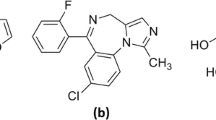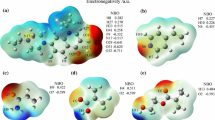Abstract
Molecularly imprinted poly(hydroxyethyl methacrylate) microspheres (PHEMA MIPMs) were prepared via precipitation polymerization in this article, using gatifloxacin (GFLX), hydroxyethyl methacrylate (HEMA), and ethylene glycol dimethacrylate (EGDMA) as template molecule, functional monomer and cross-linker, respectively. The effects of reaction medium, initial total monomers, cross-linker and molecular imprinting on the polymerization were investigated systematically. The interaction between GFLX and HEMA in pre-solution was studied by UV–Visible spectrophotometer, both size and morphology of products were characterized by a scanning electron microscope. When the total initial monomer concentration was 1 vol%, EGDMA content was 70 mol%, a group of uniform PHEMA MIPMs were prepared at different GFLX/MAA molar ratios, with diameter range from 2.06 ± 0.07 to 2.82 ± 0.20 μm. The results of drug loading and in vitro release experiments demonstrated that PHEMA MIPMs could achieve a higher GFLX loading content and a more acceptable sustained release than non-imprinted ones.








Similar content being viewed by others
References
Poma A, Turner APF, Piletsky SA. Advances in the manufacture of MIP nanoparticles. Trends Biotechnol. 2010;28(12):629–37.
Li XX, Hao LF, Hao LF, Huang YP, Duan HQ, Liu ZS. Release evaluation of molecularly imprinted polymers prepared under molecular crowding conditions. Polym Eng Sci. 2012;52(5):1440–9.
Hong CC, Lin CC, Hong CL, Chang PH. Enhanced anesthetic propofol biochips by modifying molecularly imprinted nanocavities of biosensors. Biomed Microdevices. 2012;14(3):435–41.
Li SJ, Ge Y, Tiwari A, Wang SQ, Turner APF, Piletsky SA. ‘On/off’-switchable catalysis by a smart enzyme-like imprinted polymer. J Catal. 2011;278(2):173–80.
Kryscio DR, Peppas NA. Critical review and perspective of macromolecularly imprinted polymers. Acta Biomater. 2012;8(2):461–73.
Abdouss M, Deilami SA, Asadi E, Shariatinia Z. Synthesis of molecularly imprinted polymer as a sorbent for solid phase extraction of citalopram from human serum and urine. J Mater Sci Mater Med. 2012;23(6):1543–52.
Liu BH, Han MY, Guan GJ, Wang SH, Liu RY, Zhang ZP. Highly-controllable molecular imprinting at superparamagnetic iron oxide nanoparticles for ultrafast enrichment and separation. J Phys Chem C. 2011;115(35):17320–7.
Xu ZX, Chen S, Huang W, Fang GZ, Hua PZ, Wang S. Study on an on-line molecularly imprinted solid-phase extraction coupled to high-performance liquid chromatography for separation and determination of trace estrone in environment. Anal Bioanal Chem. 2009;393(4):1273–9.
Cirillo G, Iemma F, Puoci F, Parisi OI, Curcio M, Spizzirri UG, et al. Imprinted hydrophilic nanospheres as drug delivery systems for 5-fluorouracil sustained release. J Drug Target. 2009;17(1):72–7.
Wang CY, Javadi A, Ghaffari M, Gong SQ. A pH-sensitive molecularly imprinted nanospheres/hydrogel composite as a coating for implantable biosensors. Biomaterials. 2010;31(18):4944–51.
Walsh R, Osmani Q, Hughes H, Duggan P, Mcloughlin P. Synthesis of imprinted beads by aqueous suspension polymerisation for chiral recognition of antihistamines. J Chromatogr B. 2011;879(30):3523–30.
Kobayashi T, Faizal CKM, Son LT. Hybrid molecularly imprinted membranes for targeted tocopherol: uses of cross-linked copolymer particles prepared by surfactant-free dispersion technique. J Sep Sci. 2009;32(19):3327–33.
Zu BY, Zhang Y, Guo XZ, Zhang HQ. Preparation of molecularly imprinted polymers via atom transfer radical “bulk” polymerization. J Polym Sci Pol Chem. 2010;48(3):532–41.
Zhao HY, Liu XR, Fu N, Zhang QX, Wang NY, He LQ, et al. Preparation of PBAS core-shell structured polymer by seeded emulsion polymerization and investigation in AS resin toughness. J Appl Polym Sci. 2012;125(5):3419–28.
Wang JF, Cormack PAG, Sherrington DC, Khoshdel E. Synthesis and characterization of micrometer-sized molecularly imprinted spherical polymer particulates prepared via precipitation polymerization. Pure Appl Chem. 2007;79(9):1505–19.
Ibrahim HK, EI-Leithy IS, Makky AA. Mucoadhesive nanoparticles as carrier systems for prolonged ocular delivery of gatifloxacin/prednisolone bitherapy. Mol Pharm. 2010;7(2):576–85.
Fukuda M, Yamada M, Kinoshita S, Inatomi T, Ohashi Y, Uno T, et al. Comparison of corneal and aqueous humor penetration of moxifloxacin, gatifloxacin and levofloxacin during keratoplasty. Adv Ther. 2012;29(4):339–49.
Hu XH, Hao LY, Wang HQ, Yang XL, Zhang GJ, Wang GY, et al. Hydrogel contact lens for extended delivery of ophthalmic drugs. Int J Polym Sci. 2011;2011:1–9.
Malaekeh-Nikouei B, Ghaeni FA, Motamedshariaty VS, Mohajeri SA. Controlled release of prednisolone acetate from molecularly imprinted hydrogel contact lenses. J Appl Polym Sci. 2012;126(1):387–94.
Xu JK, Li XS, Sun FQ. Cyclodextrin-containing hydrogels for contact lenses as a platform for drug incorporation and release. Acta Biomater. 2010;6(2):486–93.
Xiao DL, Dramou P, Xiong NQ, He H, Li H, Yuan Dh, Dai H. Development of novel molecularly imprinted magnetic solid-phase extraction materials based on magnetic carbon nanotubes and their application for the determination of gatifloxacin in serum samples coupled with high performance liquid chromatography. J Chromatogr A. 2013;1274:44–53.
Tan F, Sun DM, Gao JS, Zhao Q, Wang XC, Teng F, Quan X, Chen JW. Preparation of molecularly imprinted polymer nanoparticles for selective removal of fluoroquinolone antibiotics in aqueous solution. J Hazard Mater. 2013;244:750–7.
Zhang XJ, Gao XY, Huo PW, Yan YS. Selective adsorption of micro ciprofloxacin by molecularly imprinted functionalized polymers appended onto ZnS. Environ Technol. 2012;33(17):2019–25.
Zhang H, Dramou P, He H, Tan SH, Chuong PH, Pan HJ. Molecularly imprinted stationary phase prepared by reverse micro-emulsion polymerization for selective recognition of gatifloxacin in aqueous media. J Chromatogr Sci. 2012;50(6):499–508.
Shi YF, Lv HL, Lu XF, Huang YX, Zhang Y, Xue W. Uniform molecularly imprinted poly(methacrylic acid) nanospheres prepared by precipitation polymerization: the control of particle features suitable for sustained release of gatifloxacin. J Mater Chem. 2012;22(9):3889–98.
Ribeiro A, Veiga F, Santos D, Torres-Labandeira JJ, Concheiro A, Alvarez-Lorenzo C. Bioinspired imprinted PHEMA-hydrogels for ocular delivery of carbonic anhydrase inhibitor drugs. Biomacromolecules. 2011;12(3):701–9.
Chouhan R, Bajpai AK. An in vitro release study of 5-fluoro-uracil (5-FU) from swellable poly-(2-hydroxyethyl methacrylate) (PHEMA) nanoparticles. J Mater Sci Mater Med. 2009;20(5):1103–14.
Wu LF, Brazel CS. Surface crosslinking for delayed release of proxyphylline from PHEMA hydrogels. Int J Pharm. 2008;349(1–2):1–10.
Zhu GF, Gao YB, Gao X, Fan J. The synthesis and specific adsorption performance of gatifloxacin molecularly imprinted polymer microspheres. Acta Chim Sinica. 2011;69(8):973–80.
Du ZW, Liu XY, Zhao XD. The synthesis and performance research of TNT molecularly imprinted polymer microspheres. Acta Polym Sin. 2010;3:360–5.
Esfandyari-Manesh M, Javanbakht M, Atyabi F, Badiei A, Dinarvand R. Effect of porogenic solvent on the morphology, recognition and release properties of carbamazepine molecularly imprinted polymer nanospheres. J Appl Polym Sci. 2011;121(2):1118–26.
Yoshimatsu K, Yamazaki T, Chronakis IS, Ye L. Influence of template/functional monomer/cross-linking monomer ratio on particle size and binding properties of molecularly imprinted nanoparticles. J Appl Polym Sci. 2012;124(2):1249–55.
Wang Y, Wang EL, Wu ZM, Li H, Zhu Z, Zhu XS, et al. Synthesis of chitosan molecularly imprinted polymers for solid-phase extraction of methandrostenolone. Carbohyd Polym. 2014;101:517–23.
Zhang WP, Chen ZL. Preparation of micropipette tip-based molecularly imprinted monolith for selective micro-solid phase extraction of berberine in plasma and urine samples. Talanta. 2013;103:103–9.
Beltran A, Borrull F, Cormack PAG, Marce RM. Molecularly-imprinted polymers: useful sorbents for selective extractions. Trend Anal Chem. 2010;29(11):1363–75.
Singh BK, Parwate DV, Dassarma IB, Shukla SK. Radiation sterilization of fluoroquinolones in solid state: investigation of effect of gamma radiation and electron beam. Appl Radiat Isotopes. 2010;68(9):1627–35.
Abdouss M, Asadi E, Azodi-Deilami S, Beik-mohammadi N, Aslanzadeh SA. Development and characterization of molecularly imprinted polymers for controlled release of citalopram. J Mater Sci Mater Med. 2011;22(10):2273–81.
Azodi-Deilami S, Abdouss M, Javanbakht M. The syntheses and characterization of molecularly imprinted polymers for the controlled release of bromhexine. Appl Biochem Biotech. 2011;164(2):133–47.
Shi YF, Lv HL, Fu YY, Lu QJ, Zhong JX, Ma D, Huang YX, Xue W. Preparation and characterization of a hydrogel carrier to deliver gatifloxacin and its application as a therapeutic contact lens for bacterial keratitis therapy. Biomed Mater. 2013;8(5):055007.
Acknowledgments
This work was supported by SRF for ROCS, SEM (23609008), NSFC (31271019), the Key Project of Scientific and Technological Innovation of Colleges and Universities of Guangdong (cxzd1109); the Guangdong Natural Science Foundation (S2011010004545), Science and Technology Projects of Guangdong Province (2011B031300006).
Author information
Authors and Affiliations
Corresponding author
Additional information
Xue-Fei Lu and Yun-feng Shi contributed equally to this work.
Rights and permissions
About this article
Cite this article
Lu, XF., Shi, Yf., Lv, HL. et al. Preparation and characterization of molecularly imprinted poly(hydroxyethyl methacrylate) microspheres for sustained release of gatifloxacin. J Mater Sci: Mater Med 25, 1461–1469 (2014). https://doi.org/10.1007/s10856-014-5191-7
Received:
Accepted:
Published:
Issue Date:
DOI: https://doi.org/10.1007/s10856-014-5191-7




